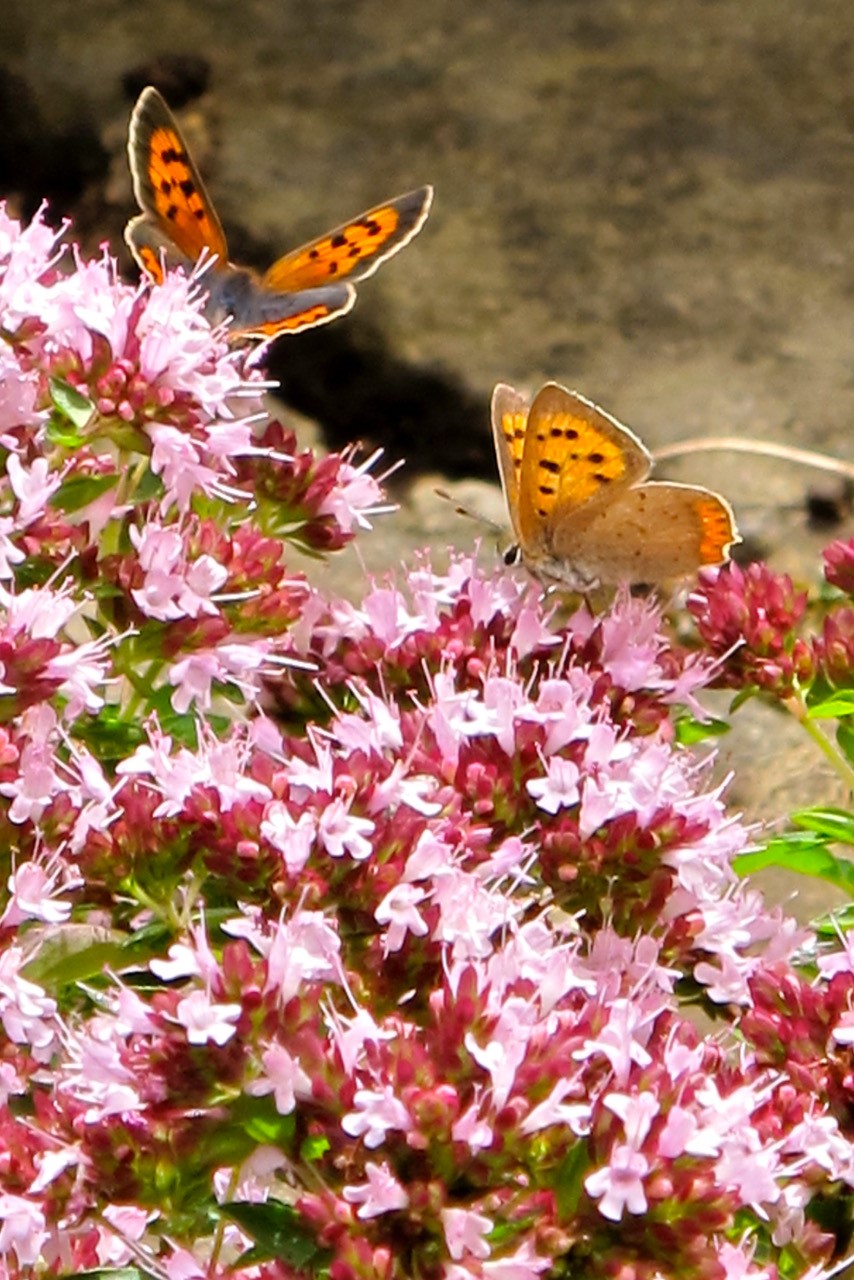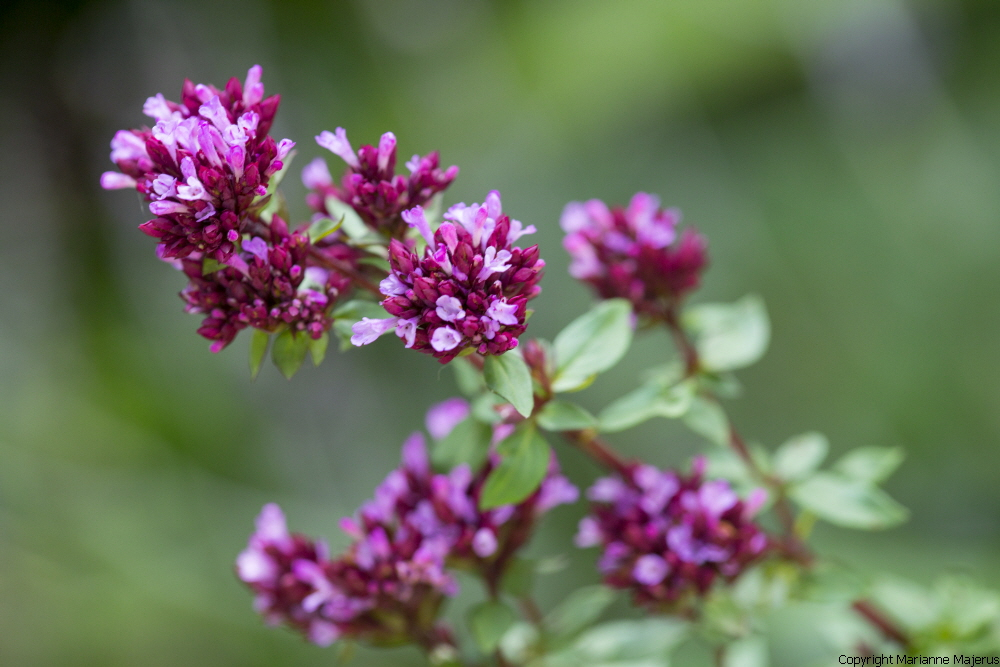
I do love plants with silvery foliage, the trouble is they’re difficult in Cold Aston because we get a lot of rainfall dumped upon us and silvery plants hate wet. They would much rather grow on thin soil in places like East Anglia – where rainfall is far lighter. However I’ve developed an area, underneath the study window, where I can grow some of my favourite silvers, ones that wouldn’t do elsewhere. It faces due south and bakes in summer.
I have two plants of a fine-leaved scabious called Scabiosa graminifolia. They’re precious to me because the great plantsman, the late Alan Bloom, introduced me to this alpine plant in the mid 1990s. He gave me one plant, but I struggled to keep it here. Luckily Jaime Blake, who is now in charge of Alan’s Dell Garden in Bressingham in Norfolk, gave me another. Whenever I see this plant in flower I think of Alan Bloom, who was a dear friend to me. I conjure up winter evenings in Alan’s study, with a log fire, Schubert playing in the background and a bar of Cadbury’s milk to share. In summer Alan and I would sit on a bench and talk plants and I can’t tell you how special he was.
The area under my study window is also perfect for dainty dianthus and other species scabious with silvery foliage. Most silvers tend to look awful in winter and for the last ten years or so I have been encouraging the black strappy grass-like plant, Ophiopogon planiscapus ‘Nigrescens’ to wander through the whole area. The black leaves help to hide any tatty silver foliage and make the area look less bleak in winter. The ophiopogon also helps to drain the soil and deflect the worst of the weather from my silvers. So far, so good.
At the back end of last year the Best Beloved decided to tidy up this area and carefully removed all the ophiopogon because it “was everywhere”. I took it quite well under the circumstances. The Best Beloved does neat, rather than artistic, and he likes control. I would rather see unrestrained ebullience, rather like underwear that isn’t man enough for the job. I want to feel that the garden might break out at any time and revert to nature. Neat control is not for me!
Luckily my prized Scabiosa graminifolia plants have come through the winter, despite the Best Beloved, and both are showing leaf. Silvery plants have adapted to hot sunshine and dry conditions and they add sparkle to any garden. They often have hairy, aromatic or needle-like foliage and these are all devices that help them survive in strong sunshine. The oily coating, on plants like lavender, protects the leaf. Dianthus and rosemary have fine needle-like foliage, to lessen transpiration, and some foliage is hairy as well. The pale silvery colour absorbs less heat.
The flowers of silvery plants vary, but many of the summer-flowering ones have sugar-packed nectar that’s actively sought out by butterflies and bees. We are lucky enough to have small copper butterflies in our garden, because the field beyond is full of sorrel (Rumex acetosa), a dock relative that’s one of the small copper’s preferred food plants. In high summer there’s a pink haze through the field over the wall. Butterflies can appear between May and October, but most arrive on hot days in July or August. Their favourite plant is a compact oregano with round heads of pale-pink flowers – Origanum vulgare ‘Compactum’. It will be studded with them, when the flowers are perfect. Our plant is growing on a paved stone area that gets very hot.
Small tortoiseshells seem to prefer the taller O. laevigatum ‘Herrenhausen’, one of my favourite plants. The sprays of mauve and pink flowers last a long time and a delicate seed head follows on. Herrenhausen is a district of Hanover in Germany and there used to be lots of nurseries there. It’s an easy garden plant and it grows in quite damp places here.
I’ve grown a large-leaved ornamental sage called Salvia officinalis ‘Berrgarten’ for over thirty years and this was a favourite of the late Beth Chatto. She used it to separate the finely divided foliage of artemisias, fennel and achilleas. It has velvety, oval leaves that are much more substantial than other culinary sage. The flowers also look as they’re on steroids, to use a Bob Flowerdew term! It will make a large plant, but the foliage survives well in winter so it’s useful in the kitchen.
The purple-leaved culinary sage, ‘Purpurascens’ also makes a good garden plant and, as the days heat up, the foliage gets as dark as damson jam. The flowers are a deeper purple-blue, so this provides a useful contrast among silvers and it’s beloved by bees.
Nepetas, or catmints, are equally bee-pleasing and I’m helping ( or not helping ) to judge the current Nepeta trial being held at RHS Wisley. I’m finding it very hard because they are extremely similar. Even common plants, such as ‘Six Hills Giant’ are dividing the panel. The form I’ve grown for many years has fine sprays of lavender-blue flowers. Many of the lower clusters of flower have a pair of leaves opposite each flower. The whole thing sprawls, with almost horizontal stems. That’s fine on dry soil, but in Cold Aston it turns into a floppy monster. However some of the plants we have on the trial are very upright with very solid flower heads.

The original ‘Six Hills’ was discovered in by Clarence Elliott ( 1881 – 1969 ) who used to have the Six Hills Nursery near Stevenage. It was an important nursery and Clarence, who collected plants in the wild, employed several famous horticulturists including Graham Stuart Thomas, Will Ingwerson and E.K Balls.
Six Hills closed in 1954 and the land was used to build houses.
Clarence, who I never met, moved to Broadwell in The Cotswolds to be near his son Joe Elliott, who also ran a nursery. His grandson Martin still has a nepeta thought to be the real Six Hills version. Hopefully this will sort out the riddle.
The great thing about trialling plants is the discovery of something new. N. grandiflora ‘Summer Magic’ was launched by Hardy’s Cottage Garden Plants at Chelsea 2013. It was raised by Malcolm Spencer and it produces lavender-blue flowers between May and October, without sprawling everywhere. It’s been a winner on the trial, particularly with the bees. I’ve mingled mine through that large-leaved sage, ‘Berrgarten’, in a sunny spot and hope both will do well. Let’s hope the Best Beloved doesn’t weed it out for me!
A Postscript
Clarence will probably be remembered for his chickens, more than his plants. He collected animals for London Zoo and in 1928 he returned with a Galapagos turtle he had saved from being eaten, a pair of pygmy deer, various birds and giant edible frogs. There were also three Araucana hens from Patagonia, which laid blue eggs. These were given to scientists at Cambridge University who used them for crossbreeding. Their descendants produce pastel-blue eggs. Clarence Court eggs pop in supermarkets. Clarence, known for his well- developed sense of humour, would have loved the irony!



